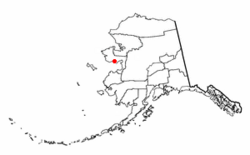White Mountain, Alaska facts for kids
Quick facts for kids
White Mountain
Nasirvik (Inupiaq)
|
|
|---|---|

Location of White Mountain, Alaska
|
|
| Country | United States |
| State | Alaska |
| Census area | Nome |
| Incorporated | July 15, 1969 |
| Area | |
| • Total | 2.05 sq mi (5.30 km2) |
| • Land | 1.82 sq mi (4.73 km2) |
| • Water | 0.22 sq mi (0.57 km2) |
| Elevation | 62 ft (19 m) |
| Population
(2020)
|
|
| • Total | 185 |
| • Density | 101.37/sq mi (39.14/km2) |
| Time zone | UTC-9 (Alaska (AKST)) |
| • Summer (DST) | UTC-8 (AKDT) |
| ZIP code |
99784
|
| Area code | 907 |
| FIPS code | 02-84070 |
| GNIS feature ID | 1411989 |
White Mountain is a small city in Alaska, United States. Its name in the local Iñupiaq language is Inupiaq: Nasirvik, which means "mountain look-out point." It is located in the Nome Census Area.
In 2020, about 185 people lived there. Most of the people in White Mountain are Alaska Natives. They often rely on traditional ways of life, like hunting and fishing. White Mountain is special because it's the only village on the Seward Peninsula that is not right on the ocean.
Contents
History of White Mountain
The area where White Mountain is today started as an Eskimo fish camp. It was called Nachirvik. This name means "mountain look-out point." The nearby Niukluk and Fish rivers provided lots of resources. These rivers helped support the Native people living there.
Growth and Early Buildings
The community grew when many gold prospectors arrived. This happened during the Klondike Gold Rush. The first building not built by Native people was a warehouse. A miner named Charles D. Lane built it. He used it to store supplies for his gold claim.
Later, a government-supported orphanage was built. It became a school for learning trades in 1926. The Covenant Church was built in 1937. An old Russian Orthodox Church building from around 1920 is still standing today. A post office opened in 1932. The local tribal government was formally organized in 1939. The city officially became a city in 1969.
White Mountain and the Iditarod Race
Today, White Mountain is famous for something exciting. It is one of the last stops for teams in the Iditarod. This is a very long sled dog race. All mushers (people who drive dog sleds) must stop here. They have to rest for 8 hours. After this rest, they make their final push to the finish line. The finish line is in Nome, about 77 miles (124 km) away.
Geography of White Mountain
White Mountain is located at coordinates 64.680856 degrees North and -163.406538 degrees West. The city sits on the eastern bank of the Fish River.
The city covers a total area of about 2.0 square miles (5.3 square kilometers). Most of this area, about 1.8 square miles (4.6 square kilometers), is land. The rest, about 0.2 square miles (0.6 square kilometers), is water.
Population and People
| Historical population | |||
|---|---|---|---|
| Census | Pop. | %± | |
| 1920 | 198 | — | |
| 1930 | 205 | 3.5% | |
| 1940 | 199 | −2.9% | |
| 1950 | 129 | −35.2% | |
| 1960 | 151 | 17.1% | |
| 1970 | 87 | −42.4% | |
| 1980 | 125 | 43.7% | |
| 1990 | 180 | 44.0% | |
| 2000 | 203 | 12.8% | |
| 2010 | 190 | −6.4% | |
| 2020 | 185 | −2.6% | |
| U.S. Decennial Census | |||
White Mountain first appeared in the U.S. Census in 1920. It was officially made a city in 1969.
In 2000, there were 203 people living in White Mountain. Most of the people were Alaska Natives, making up about 83.7% of the population. About 13.3% were White. A small number of people were from other backgrounds.
Many households in White Mountain had children under 18. The average household had about 2.94 people. The average family had about 3.55 people. The median age in the city was 29 years old. This means half the people were younger than 29 and half were older.
Education in White Mountain
Students in White Mountain attend schools run by the Bering Strait School District. The main school is White Mountain School. It teaches students from pre-kindergarten all the way through 12th grade.
New School Building
Before 2009, students went to two different buildings. There was a high school building and an elementary building. In 2006, the high school building caught fire and burned down. High school and junior high students had to use other buildings for a few years.
The elementary school building was very old. It was the oldest operating school building in Alaska. But in 2009, a brand new school building was finished. The old elementary building was later taken down in 2010. The new White Mountain School is one large building. It has rooms for elementary students, junior high, and high school. It also has a gym, a cafeteria, a library, and staff rooms.
See also
 In Spanish: White Mountain (Alaska) para niños
In Spanish: White Mountain (Alaska) para niños

